
Today is the 100th post of the Weekend Designer and the last one for this blog. It seems like a good place to stop as I believe I have made my point that everyone is a designer and that making your own pattern “isn’t rocket science”. Weekend Designer has been a fun project as I have discovered the world of blogging and explored desktop publishing. My aim with the subject matter is to show how to execute those creative ideas for your wardrobe and home through pattern drafting. Some of the drafting techniques used were traditional flat pattern methods, drafting by height, transfer grids, simple block designs, and sometimes no pattern at all. While the examples cited are not complex, I have been able to show that making your own patterns is not a talent that you are born with nor a blessed gift, but simply a learned skill. It is like learning a new language. The more you practice it, the more fluent you become. Pattern drafting will allow you to make your creative ideas into reality.
Fabrics, trims, buttons, and embellishments are among our favourite resources for expressing our creativity in fashion design. There is something particularly special and rewarding about designing and wearing your own creations or decorating your home interiors. Garments speak a language; they are an extension of yourself, expressing personality, aspirations, moods, and style. When you know you look great, it’s only natural to feel positive and confident about yourself. The same can be said of our home decor.
You do not have to be an expert to be your own designer. With simple pattern modifications and some common sense ( sometimes a bit of trial and error too), you can create your own design details. When combined with the ideal fabrications you can realize your own creative visions.
You’ve probably discovered many sources of inspiration from the Weekend Designer. Here are some design tips and advice to help you turn that inspiration into creativity.
- Be Disciplined – Pattern-making can be hard work and takes concentration. A defined work-space and a preplanned time frame are often helpful. Try to plan creative time every day, or whatever time is available to your lifestyle. Planning a time frame in a space where you can concentrate will help slow down your ideas so you can actually be productive with them. If you’re in a hurry or if the ideas come too fast, it’s difficult to convert them into a design.
- Be Prepared – Pattern-making is a skill. However to make that skill work to its best advantage, you need the proper tools and supplies. Take precise and accurate measurements. It does not matter whether amounts are in imperial or metric but be consistent with whichever you choose. The applied math is basic but if you cannot convert fractions then use a calculator as an aid. Get a long straight ruler (yardstick) to draw lines, a set square to make 90° and 45° angles, a French curve to draw curved lines and a tracing wheel. You are only as good as your tools you use. Get a good sewing reference book. The more you know about sewing construction, the more you can expand on your pattern-making.
- Set Goals – Channel your creativity by setting goals. Let your goals grow as you grow in your knowledge of pattern drafting. Perhaps your goal is to resolve a particular design challenge or to redesign a fashion detail and integrate it into your next design. Know that pattern drafting will eventually free you of “cookie-cutter” fashion and develop a personal made-to-measure style. One technique that I always use is to begin each project with a list of “what do I see”. This will set up your thinking as to how to proceed with your pattern-making.
- Value Mistakes – Believe it or not, mistakes can be beneficial. They cause us to search for a different and often better way. They facilitate experimentation with new materials, techniques, or styles. Mistakes or challenges are an important part of the design process because they provide unique opportunities for creativity. Always make a toile or muslin fitting to test your pattern before cutting into your fashion fabric. Don’t be disappointed if it does not ‘turn out ‘ on the first attempt as planned; that is what toiles are for. These mock-ups allow you to modify the end result, correct the pattern, and work out the sewing/assembly process.
- Temporarily Let Go – When you have a creative block or cannot find a resolution to a design problem, there comes a time when it may be more productive to stop working on the pattern drafting. Let it go; do something else. While you have consciously stopped thinking about the problem, your mind is still working on it. Sometime we get too close to see the answer; however when we step back there is room for clarity.
- Enjoy the Process – don’t forget the reason why you’re doing this. Is this your hobby, your career, your creative release, your personal time for indulgence? Even if your concentration is on the end product, don’t forget to have fun with the process of pattern drafting.
Lastly, I would like to thank all the readers of Weekend Designer for their interest, comments, compliments, and encouragement. Many of you have set up links to this blog and made referrals to it in your sewing groups. Thank you for your support. Imagine my surprise and delight when I made the Top 100 Blogs on WordPress; it was all your doing.
Thank you again.
Wishing you many a creative weekend.
Don
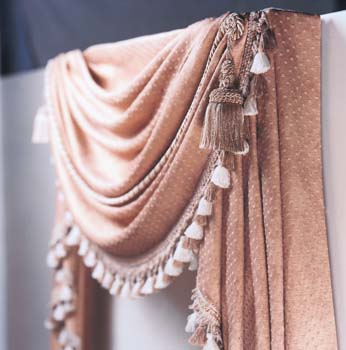 Photo Credit: Arlene’s Interiors
Photo Credit: Arlene’s Interiors MEASUREMENTS
MEASUREMENTS
 Mark the center of the top and bottom edges of the swag pattern (A-B).
Mark the center of the top and bottom edges of the swag pattern (A-B).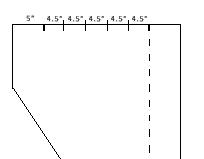 markings on opposite side and open pattern flat.
markings on opposite side and open pattern flat.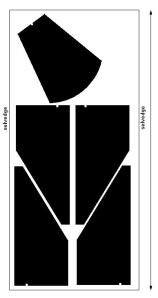
 Featured: Club Jacket by Sanmar
Featured: Club Jacket by Sanmar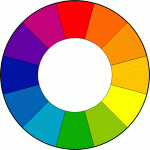
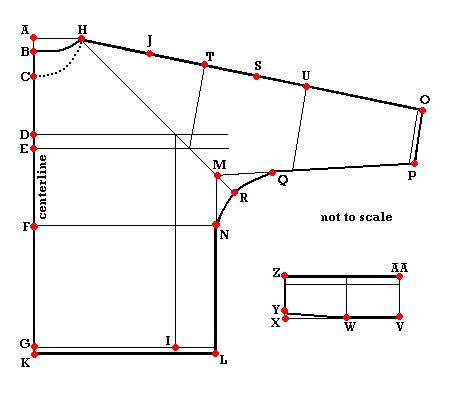
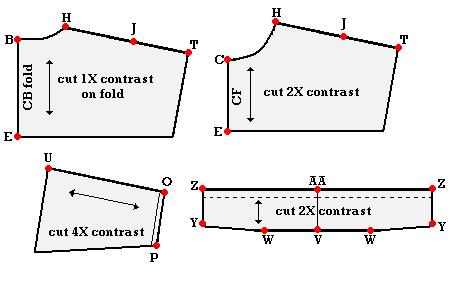
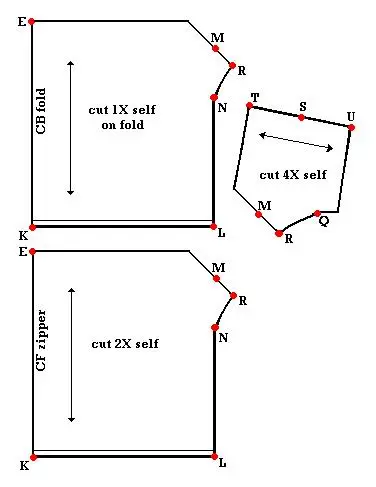
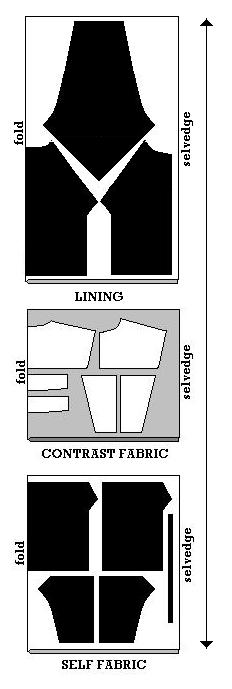

 Featured: Turtle Tote by LIFEwithBIRD
Featured: Turtle Tote by LIFEwithBIRD
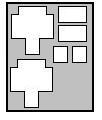 Cut 2 of each piece in fabric.
Cut 2 of each piece in fabric.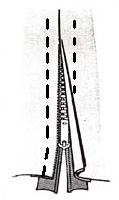 Center zipper FACE down along opening in seam. Stitch zipper tape to seam allowances.
Center zipper FACE down along opening in seam. Stitch zipper tape to seam allowances. Open zipper and turn out bag through opening. With RST, join A to A and sew across seam, ensuring the straps are caught in the seam. (Be careful not to twist the straps.)
Open zipper and turn out bag through opening. With RST, join A to A and sew across seam, ensuring the straps are caught in the seam. (Be careful not to twist the straps.)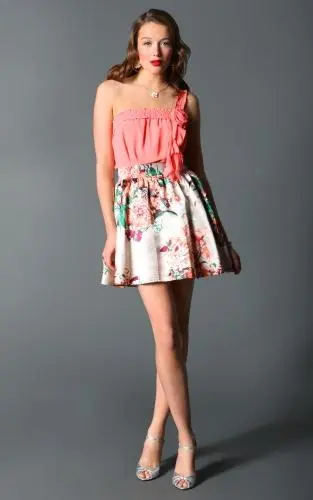 Featured: Wrap Skirt by Charlotte Russe
Featured: Wrap Skirt by Charlotte Russe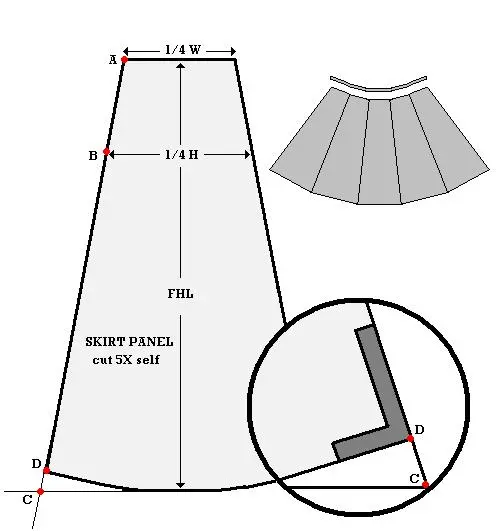 Draw a T shape with the vertical base equal to the Finished Hem Length (FHL) and the centered horizontal top equal to ¼ of the Waist measurement (W).
Draw a T shape with the vertical base equal to the Finished Hem Length (FHL) and the centered horizontal top equal to ¼ of the Waist measurement (W).
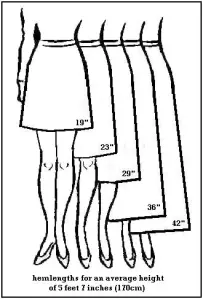 Cut 5 panels for each fabric. **
Cut 5 panels for each fabric. **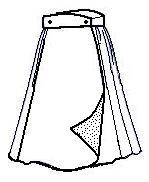 Turn all seam allowances to inside of waistband and align folded edge to machine-stitching on skirt waistline. Edge-stitch around perimeter of the waistband.
Turn all seam allowances to inside of waistband and align folded edge to machine-stitching on skirt waistline. Edge-stitch around perimeter of the waistband. Featured: Mitered Pillows by Foley & Cox HOME
Featured: Mitered Pillows by Foley & Cox HOME
 The paper triangle patterns have two sides of equal length. Label the pattern with the letter X, at the center point, between these two equal sides. Label the corners on the unequal side with the letter O. With the points and corners of each triangle facing in the same direction, position the triangles on the striped fabric so each O-O line is parallel to and measures the same distance from a stripe. Mark and cut 8 identical triangles from fabric; four for pillow front and four for pillow back.
The paper triangle patterns have two sides of equal length. Label the pattern with the letter X, at the center point, between these two equal sides. Label the corners on the unequal side with the letter O. With the points and corners of each triangle facing in the same direction, position the triangles on the striped fabric so each O-O line is parallel to and measures the same distance from a stripe. Mark and cut 8 identical triangles from fabric; four for pillow front and four for pillow back.
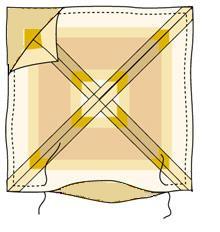 3. With right sides of fabric facing, pin pillow front to pillow back along all edges. Sew front to back using ½” [12mm] seam allowance and leaving a wide opening at the center of one edge. Clip corners and press seams open. Turn mitered pillow cover to the right side through opening and press flat.
3. With right sides of fabric facing, pin pillow front to pillow back along all edges. Sew front to back using ½” [12mm] seam allowance and leaving a wide opening at the center of one edge. Clip corners and press seams open. Turn mitered pillow cover to the right side through opening and press flat. Featured: Selma dress
Featured: Selma dress
 With FACE side up, shirr fabric panels using elastic thread in the bobbin. Begin 1” from top edge of panel and stitch across width of each panel. Do parallel rows of
With FACE side up, shirr fabric panels using elastic thread in the bobbin. Begin 1” from top edge of panel and stitch across width of each panel. Do parallel rows of 

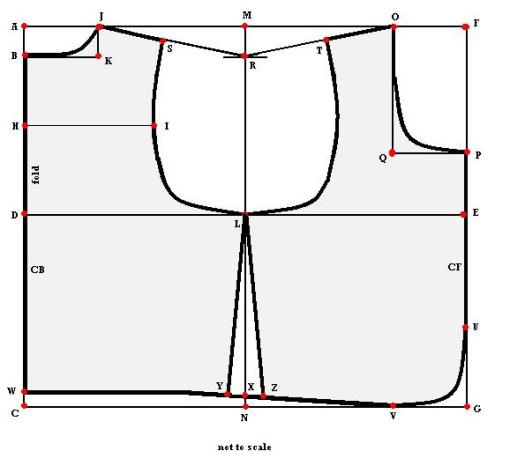
 Cut 2 bias strips 2 ½” wide [65mm] in lining fabric.
Cut 2 bias strips 2 ½” wide [65mm] in lining fabric. Featured: Imperial Dog Palace from Victoria Trading Co.
Featured: Imperial Dog Palace from Victoria Trading Co.
 For the exterior cover, center the zipper between X and O and align the foldline along the zipper teeth. Pin/baste zipper in place and topstitch fabric to zipper tape.
For the exterior cover, center the zipper between X and O and align the foldline along the zipper teeth. Pin/baste zipper in place and topstitch fabric to zipper tape. Fold each notched corner and align and match the raw edges to form a miter. Pin/baste and sew seam at each corner.
Fold each notched corner and align and match the raw edges to form a miter. Pin/baste and sew seam at each corner.